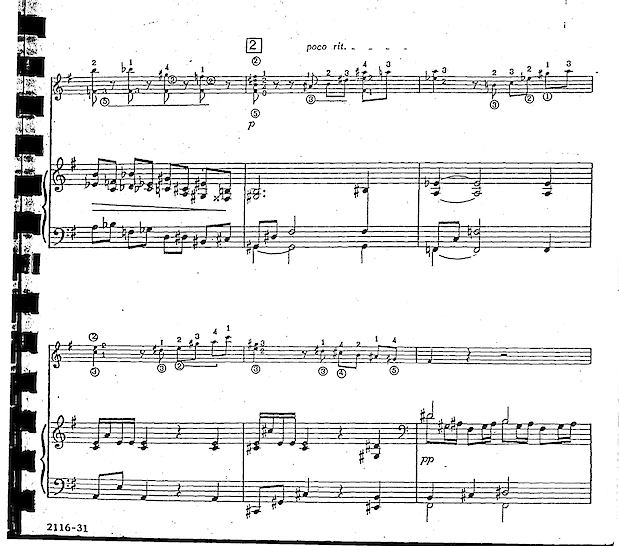Manuel Ponce's Sonata for Guitar and Harpsichord and Schoenberg 4th String Quartet
Polemic revionists, or revisionist polemicists lately argue, "no to Schoenberg, yes to Sibelius!"
No to Schoenberg, yes to Sibelius!
I'm saying here, yes to Schoenberg and yes to Manuel Ponce.
I do not argue with Milton Babbitt's essay about Schoenberg's 4th quartet. (See his complied essays, edited by Strauss, Dembski and some others.) There, he asks us to hear the target of the exposition embedded in the viola part in the opening bars. In this quartet, a hexachord, a pretty brutal one, is transposed by a fifth instead of diatonic scale that is established as a *key* and transposed by a fifth. For Schoenberg the key is that hexachord. Keys have to be established and that can be done well, badly or perfunctorily. Hexachords are more difficult to establish, and moreover, Schoenberg was more ambitious than that. His opening argument would establish an "O" hexachord, that will be instated such that we feel at home there, and in that opening argument he will also show where he's going with it; he begins his pointing. Babbitt argues, convincingly, that the target transposition --I think he calls it S\2(?) -- is embedded in a viola part and that it's there to point forward, to forshadow a transposition of the focal hexachord by a fifth.
Babbitt is honest enought to admit that hearing that S\2 hexachord is a lot to ask, but I have no doubt that Babbitt and Schoenberg could hear it.
I own that I was agnostic about the question of our ability to discern subsets of sets. But timbres are at play. The viola sounds like a viola, and we can discern viola doings from violin and cello doings.
I ask you to put a pin in that and move on to Manuel Ponce's Sonata for Guitar and Harprischord --

Like a fugue, the guitar does what the harpsichord does a fifth up. As a sonata form, the guitar is pointing to the a target trasnsposition up a fifth. But there are wonderful chord quality doings alongside those transpositional doings. "Chord quality" was later redeisgnated "set class", reflecting the reality that a chord retains identity through various reassignments of registers of its constituents. We were taught chord quality -- how to hear a minor 7th chord and distinguish it from a major 7th chord.
The guitar does something that the harpsichord leaves somewhat unfinished. The F natural in the harpsichord introduces a tritone to the B natural. The C natural in the guitar introduces the analogous tritone transposed up a 5th, but at the very end of the 4th bar that tritone is purged --

I play the piece and so I can tell you how easy it is to disentangle the guitar part from the aggregate. We can hear a pure [E, A, B] in the guitar part on beat for of meassure 4.
What's lovely about it is that the harpsichord spins that collection, placing it in a dominant 9 chord.
That A9 has another tritone, [C#, G]
The opening guitar figure is very much in a modal E minor. That 4th beat is a signature of *modal e minor*, yet the harpsichords spinning of that, witht the major IV9 demonstrates our ability to hear two chord quality arguments at once, one in the guitar and one in the harpsichord.
These proceedings continue in a dazzling fashion. Now dig this --

At rehearsal number 2, in the box, the guitar has hit the target, arriving at the V chord in 2nd inversion, but the harpsichord is not there yet, spinning B major into G# minor 7. The guitar feels arrived, but not the aggregate. And our ears really can hear a straight B major triad in the guitar as a subset of a G# minor7 chord.
The real arrival in B major is where the harpsichord converges with the guitar on a 2nd inversion B major thing. That transpositional landmark is accompanied by a chord quality achievement, or in Babbitt/Rahn parlance, a set class achievement. The 2nd theme is in the "key" of major 7th chords, with the signature trichords [045] or [015]. The set class proceedings are apples to the transpositional oranges, but they complement one another. The set class (chord quality) doings celebrate the transpositional achievement.

This is likely unthinkable without Boulanger, who pulled all this knowlege together. In the Boulanger's school, the 6/4 is the strongest indicator of a key. Ponce toys with us in lovely ways while making it very clear where he's going.
Another amazing feature of the 3 movements. The call & response comes back in the 2nd movement. The dominant 9 comes that we hear on beat 4 of measure 4 comes back joyously in the 3rd movement. Memory over a very large scale.
Now, the only problem with what Schoenberg does is that we don't have all his chord qualities in our bones. But that only takes love and listenings.
//////////////////////////////
Here's a list of fun examples of chord quality (set class) being treated like
Brahms op. 88 --
The first four notes of the tune, the first bar, is developed as a chord quality, in other words, a set class, with Major7 chords flowering in the sarabande. The structural transpositons by Major thirds are related to it, with the "natural" transpositions by 5ths superimposed over the augmented triad, the background becomes an augmented scale. Schoenberg loved that and developed the augmented scale, bringing it to the fore. Someone started calling it the E hexachord.
Ponce obviously loved Brahms.

Another 045 or Major 7 episode in Bach BWV996 --

This reminds us of the Brahms cello sonata, which is also about set classes no less than about transpositons (keys).
Fernando Sor, in the early 19th C. treats a minor 7 chord thematically.

The red circles. Measure 2 is gentle, measure 6 is hard. This creates a wonderful syncopation that propels into bar bar 8, which is cut off, a turnaround back to D major, with a G natural cancelling the G#.
Strong & weak bars --
S W S W S S(!) M M
I feel that unexpected strong bar 6 moots the strength of the next few bars until the tune reappears in bar 9.

